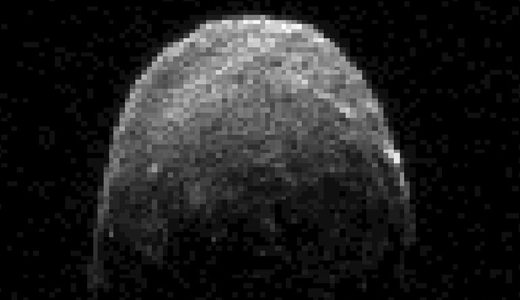
It sounds like the setup to a sci-fi film: An asteroid the size of a city block will fly right past Earth today, inside the orbit of the moon. But it will not, however, be smashing into our planet.
Lance Benner, a research scientist with NASA’s Jet Propulsion Laboratory in Pasadena, Calif. explained that the asteroid, named 2005 YU55, “cannot hit Earth, at least over the interval that we can compute the motion reliably, which extends for several hundred years.”
The space rock is about 1,300 feet across in size. And while it will pose no apocalyptic threat, it will notably be closer to the world than the moon (a bit over 201,000 miles away from Earth – compared with the moon’s 238,000+ distance from us). YU55 will be closest to Earth at approximately 6:28 p.m. Eastern time.
Despite the fact that YU55 will leave Earth unscathed, a report noted that eventually, it is inevitable that an asteroid will head straight toward us. Proof of this is obviously present throughout our history.
Researchers suggest that if we want to avoid going the way of mammoths and dinosaurs, we ought to be prepared for such a scenario. Luckily, experts seem to have solutions.
“We have the ability – physically, technically,” said former astronaut Rusty Schweickart, “to protect the Earth from asteroid impacts.” Schweickart is now chairman of the B12 Foundation, a group that aims to predict and prevent asteroid strikes. “We are now able to very slightly and subtly reshape the solar system in order to enhance human survival.”
One such method is via something called a gravity tractor. If a space rock on a doomsday path toward Earth is spotted very early on, said the report, the best option could be to send the tractor – a robotic probe – to latch itself on to the asteroid and ride shotgun. The spacecraft’s gravity would create a tug as the two sail through space, pulling the asteroid over the course of months or years in a safer direction.
According to researchers, experts already know how this would work, as they have employed similar techniques in the past. NASA’s Dawn spacecraft, for example, is currently orbiting the large asteroid Vesta.
Another, more aggressive option might remind one a little of the old arcade game, Asteroids. But this method would be quite serious. It would involve slamming a robotic probe into the space rock to alter its orbit. Again, similar approaches have been executed in the past; NASA sent an impactor smashing into the comet Tempel in 2005, in order to determine the composition of the icy object.
An even more forceful option – and a last resort – would be to blow up the rock with a nuclear weapon. The nuclear option would arise only if the asteroid were too enormous to be affected by a kinetic impactor.
Bill Nye, executive director of the Planetary Society, however, acknowledged that this method might do more harm than good. “Momentum is conserved,” Nye said. “If you blow it up, then the whole giant spray of rocks is coming at the Earth instead of one.”
Another, perhaps fringier, idea involves employing the use of ‘mirror bees.’ These would be a swarm of small, mirror-bearing spacecraft, which would be launched at the asteroid. The idea is that the ‘bees’ would aim reflected sunlight at a single spot on the space rock, heating it up so much that the asteroid is vaporized, creating propulsive jets.
Despite the fact that our world is in no immediate danger – or even long-term danger – from wayward asteroids, simply being prepared to rise to such a challenge, Schweickart feels, is an important test for mankind.
“If there is a community of intelligent life out in the universe,” said Schweickart, “Those intelligent beings will have already conquered this challenge. Our entrance exam to that community of intelligent life is to pass this test.”
As for 2005 YU55, it won’t really be visible to anyone unless that person is an amateur or professional astronomer, reported Earthsky. The reason for this is that YU55 will reach a brightness of 11th magnitude – which is very faint.
The last time an asteroid its size has come this close to Earth was in 1976, and the next known approach of a rock this size will occur in 2028.
Photo: This image of asteroid YU55, taken on the morning of Nov. 7, captured the space rock as it was 860,000 miles from Earth. NASA/JPL-Caltech http://www.nasa.gov/mission_pages/asteroids/multimedia/yu55-20111107.html












Comments